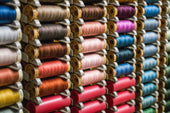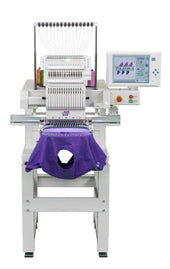
Getting Started with Domestic Sewing Machines: A Beginner’s Guide for Crafters Who’ve Used Knitting Needles
If you’ve ever wondered whether your knitting skills could open the door to new creative projects, the answer is yes. Knitters who have spent long hours working with knitting needles already hold many of the qualities needed to succeed with a domestic sewing machine. The discipline of repeating patterns, counting stitches, and correcting mistakes develops patience and focus that transfer directly into sewing. Guiding yarn evenly through your hands is not far removed from guiding fabric beneath a presser foot, and the same calm attention helps reduce the sense of intimidation that machines can create for beginners.
For crafters in New Zealand, this connection means that moving from knitting to sewing is less about starting over and more about applying familiar habits in a new way. The fibre knowledge you already rely on when choosing yarn, such as understanding stretch, weight, and texture, also applies to fabric. By recognising these shared skills, you approach a domestic sewing machine with confidence, knowing you already have the foundation needed to succeed.
Why Knitters Make Great Beginner Sewists
When knitters consider trying a sewing machine for the first time, the biggest worry is often about complexity. The buttons, dials, and moving parts look overwhelming compared to two needles and a ball of yarn. But knitters already possess the qualities that matter most.
-
Patience – You’ve trained yourself to work slowly, repeat patterns, and tolerate mistakes. That mindset transfers directly into sewing practice.
-
Attention to detail – If you have ever counted stitches or corrected a dropped loop, you understand the precision needed for sewing seams.
-
Fibre handling – Working with yarn builds confidence with texture. Domestic sewing machines deal with different fibres, but the principle of guiding material through your hands remains the same.
These skills reduce the steepness of the sewing learning curve. While others might feel discouraged after a tangled bobbin, knitters tend to keep going because they already know the value of persistence.
Knitting Needles vs. Sewing Machines: What’s the Difference?
Knitting and sewing both transform raw fibres into useful and wearable items, yet they achieve this in very different ways. The main difference lies in how each craft handles time and structure.
When you knit, you build fabric from the ground up. Each stitch connects to the next, forming a continuous piece of material. This slow process produces textiles that stretch, drape, and move with the body. A hand-knitted jumper or scarf feels personal because every loop was shaped with your own hands.
Sewing, on the other hand, starts with fabric that has already been woven or knitted in a factory. Instead of building the fabric, you focus on shaping and joining pieces together. A domestic sewing machine creates secure seams in seconds, which gives garments or home décor items their structure. The machine allows you to finish a skirt, a set of curtains, or a cushion cover in hours rather than weeks.
Despite these differences, the two crafts share much more than people often assume. Both require:
-
Knowledge of fibres and fabric behaviour – Knitters understand how yarn weight and fibre type change a garment’s fit. Sewists apply the same awareness when choosing fabric, since cotton, silk, or stretch blends all behave differently under the needle.
-
A steady rhythm – Knitting requires repeated, even loops, while sewing relies on guiding fabric smoothly under the presser foot. In both cases, rhythm prevents mistakes and keeps the work consistent.
-
Problem-solving skills – Dropped stitches in knitting are no different from tangled bobbin threads in sewing. The ability to stop, unpick, and continue without frustration is what keeps progress moving.
Another point of overlap is the satisfaction of creating something that fits your needs. A knitted blanket and a sewn tote bag both carry the same reward: you start with raw material and finish with a functional item that reflects your effort.
This shared foundation makes the transition from knitting needles to domestic sewing machines far less daunting than it appears. You are not switching hobbies or leaving one behind. You are expanding your toolkit and giving yourself more ways to work with fibre.
Choosing Your First Domestic Sewing Machine for Knitting Needles Users
Selecting your first sewing machine is an important step, and we understand that beginners want something approachable. At Sewingtime, we guide new sewists towards machines that balance ease of use with long-term reliability. Too many advanced features can overwhelm at the start, but a machine with limited functions may hold you back once you gain confidence. The right choice is one that grows with you.
Key features to look for as a beginner:
-
Straightforward threading – A clear threading path reduces frustration. Many JUKI models include automatic needle threaders, which make starting projects quicker and help you focus on stitching.
-
Versatile stitch selection – Straight and zigzag stitches are the foundation of most sewing projects. A selection of decorative stitches adds flexibility without making the interface confusing.
-
Durable build – Machines with solid construction deliver smoother operation and last longer. JUKI’s reputation in both industrial and domestic sewing means you’re investing in equipment built to handle consistent use.
-
Speed control – Beginners benefit from machines that allow slower stitching. Being able to ease into the process makes it less stressful when learning to guide fabric.
At Sewingtime, we often recommend the JUKI HZL series as a reliable starting point. Models such as the HZL-F600 and HZL-DX series combine straightforward operation with features you will continue to use as your skills improve. They handle everyday sewing projects with consistency, from simple garments to light quilting.
For those who want a more polished finish on seams, we also offer the JUKI MO overlockers. These machines trim, stitch, and overcast edges in one step, producing professional results even for beginners. Many knitters who move into sewing appreciate overlockers because they create stretchable seams that complement knitted fabrics.
Every machine we supply is backed by our technician service here in New Zealand. That means if you run into questions or need support, our team is available with practical solutions. We believe that learning on a JUKI domestic sewing machine gives you the right foundation, and it sets you up with equipment you won’t outgrow quickly.
First Projects to Try If You’re Used to Knitting Needles
Starting small helps build confidence. Knitters should choose projects where fibre familiarity makes the transition easier.
Beginner-friendly sewing projects:
-
Pillowcases – Straight seams only, perfect for learning tension control.
-
Tote bags – Reinforces straight stitching and introduces stronger seams.
-
Simple skirts or shorts – Gives knitters a chance to see how flat fabric becomes a garment.
-
Drawstring pouches – Combines straight seams with finishing techniques.
These projects highlight similarities between knitting and sewing. Just as you once celebrated finishing a scarf, completing your first pillowcase on a machine provides the same sense of progress.
Tips for Building Confidence with Domestic Sewing Machines
Confidence grows through practice, not perfection. We encourage beginners to approach the sewing machine as they once approached knitting needles: with patience and repetition.
Practical tips for smoother learning:
-
Use fabric scraps first to test stitches and learn how different materials behave.
-
Practise threading until it feels automatic. Much like casting on in knitting, threading sets the foundation.
-
Accept mistakes as part of the process. Misaligned seams are the equivalent of dropped stitches.
-
Keep sessions short at the beginning to avoid fatigue.
Your background with knitting needles will help you stay patient as you adjust. What feels complicated today becomes second nature over time.
When to Choose Sewing Over Knitting (and Vice Versa)
Both crafts serve different purposes, and knowing when to pick one over the other broadens your creative options.
When sewing makes sense:
-
Large projects like curtains, duvets, or structured garments.
-
Pieces requiring fast completion.
-
Items that need durability, such as trousers or bags.
When knitting is better:
-
Garments where stretch and comfort are priorities.
-
Accessories like hats, socks, or shawls that benefit from flexibility.
-
Slow, mindful projects where process is as rewarding as the result.
Rather than competing, these crafts complement one another. Some knitters even sew linings for hand-knitted bags or combine sewn fabric with knitted panels for unique designs.
Expanding Your Crafting Skills
Knitters often think of sewing as an intimidating skill, but the truth is that both crafts share the same patience and attention to fibre detail. Once you bring a domestic sewing machine into your workspace, you gain access to new ways of creating, from home décor to garments that complement your knitted pieces. The strengths you have built with knitting needles give you an advantage when adjusting to machine work, and that advantage keeps growing the more you practise.
Adding sewing to your set of skills is less about switching hobbies and more about broadening what you can do at home. Where knitting gives you texture and warmth, sewing provides speed and structure. Together, they allow you to approach fabric projects at home with flexibility and confidence.
At Sewingtime, we support crafters across New Zealand by offering reliable domestic sewing machines backed by expert service. We know how much patience and care go into each handmade item, whether from yarn or cloth. If you’re ready to expand your crafting, we’ll help you find a machine that feels comfortable from the start. After all, your first stitch on a domestic machine can be as satisfying as your first row on knitting needles.



